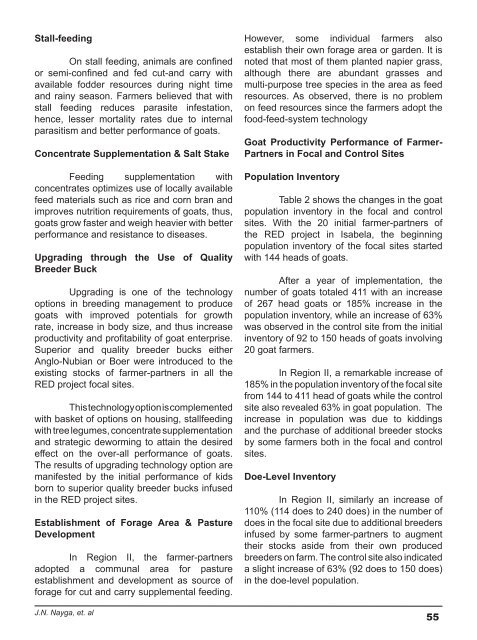download the full article here - EISRJC
download the full article here - EISRJC
download the full article here - EISRJC
Create successful ePaper yourself
Turn your PDF publications into a flip-book with our unique Google optimized e-Paper software.
Stall-feeding<br />
On stall feeding, animals are confined<br />
or semi-confined and fed cut-and carry with<br />
available fodder resources during night time<br />
and rainy season. Farmers believed that with<br />
stall feeding reduces parasite infestation,<br />
hence, lesser mortality rates due to internal<br />
parasitism and better performance of goats.<br />
Concentrate Supplementation & Salt Stake<br />
Feeding supplementation with<br />
concentrates optimizes use of locally available<br />
feed materials such as rice and corn bran and<br />
improves nutrition requirements of goats, thus,<br />
goats grow faster and weigh heavier with better<br />
performance and resistance to diseases.<br />
Upgrading through <strong>the</strong> Use of Quality<br />
Breeder Buck<br />
Upgrading is one of <strong>the</strong> technology<br />
options in breeding management to produce<br />
goats with improved potentials for growth<br />
rate, increase in body size, and thus increase<br />
productivity and profitability of goat enterprise.<br />
Superior and quality breeder bucks ei<strong>the</strong>r<br />
Anglo-Nubian or Boer were introduced to <strong>the</strong><br />
existing stocks of farmer-partners in all <strong>the</strong><br />
RED project focal sites.<br />
This technology option is complemented<br />
with basket of options on housing, stallfeeding<br />
with tree legumes, concentrate supplementation<br />
and strategic deworming to attain <strong>the</strong> desired<br />
effect on <strong>the</strong> over-all performance of goats.<br />
The results of upgrading technology option are<br />
manifested by <strong>the</strong> initial performance of kids<br />
born to superior quality breeder bucks infused<br />
in <strong>the</strong> RED project sites.<br />
Establishment of Forage Area & Pasture<br />
Development<br />
In Region II, <strong>the</strong> farmer-partners<br />
adopted a communal area for pasture<br />
establishment and development as source of<br />
forage for cut and carry supplemental feeding.<br />
J.N. Nayga, et. al<br />
However, some individual farmers also<br />
establish <strong>the</strong>ir own forage area or garden. It is<br />
noted that most of <strong>the</strong>m planted napier grass,<br />
although <strong>the</strong>re are abundant grasses and<br />
multi-purpose tree species in <strong>the</strong> area as feed<br />
resources. As observed, <strong>the</strong>re is no problem<br />
on feed resources since <strong>the</strong> farmers adopt <strong>the</strong><br />
food-feed-system technology<br />
Goat Productivity Performance of Farmer-<br />
Partners in Focal and Control Sites<br />
Population Inventory<br />
Table 2 shows <strong>the</strong> changes in <strong>the</strong> goat<br />
population inventory in <strong>the</strong> focal and control<br />
sites. With <strong>the</strong> 20 initial farmer-partners of<br />
<strong>the</strong> RED project in Isabela, <strong>the</strong> beginning<br />
population inventory of <strong>the</strong> focal sites started<br />
with 144 heads of goats.<br />
After a year of implementation, <strong>the</strong><br />
number of goats totaled 411 with an increase<br />
of 267 head goats or 185% increase in <strong>the</strong><br />
population inventory, while an increase of 63%<br />
was observed in <strong>the</strong> control site from <strong>the</strong> initial<br />
inventory of 92 to 150 heads of goats involving<br />
20 goat farmers.<br />
In Region II, a remarkable increase of<br />
185% in <strong>the</strong> population inventory of <strong>the</strong> focal site<br />
from 144 to 411 head of goats while <strong>the</strong> control<br />
site also revealed 63% in goat population. The<br />
increase in population was due to kiddings<br />
and <strong>the</strong> purchase of additional breeder stocks<br />
by some farmers both in <strong>the</strong> focal and control<br />
sites.<br />
Doe-Level Inventory<br />
In Region II, similarly an increase of<br />
110% (114 does to 240 does) in <strong>the</strong> number of<br />
does in <strong>the</strong> focal site due to additional breeders<br />
infused by some farmer-partners to augment<br />
<strong>the</strong>ir stocks aside from <strong>the</strong>ir own produced<br />
breeders on farm. The control site also indicated<br />
a slight increase of 63% (92 does to 150 does)<br />
in <strong>the</strong> doe-level population.<br />
55

















